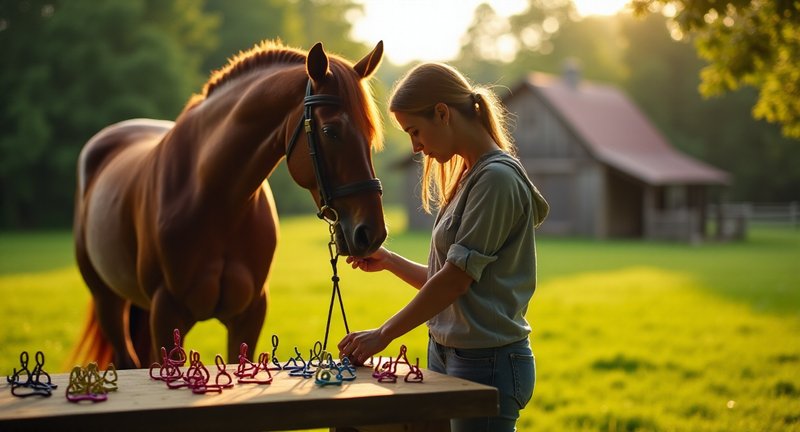A First Look at Rubber Bits for Horses
When I first came across rubber bits for horses, I have to admit, I was skeptical. Like many, I was used to the feel of metal and the weight it carried, thinking that this was essential for proper communication. But rubber bits? It felt like stepping into unknown territory.
The first thing you notice with flexible horse mouthpieces is the softness. They don’t have that cold, rigid nature of metal. Instead, they’re far more forgiving on the horse’s mouth, offering a gentler, more cushioned experience. And yes, I could see my horse visibly relax the moment we switched.
It’s interesting how these bits still provide the same control, yet with a touch of kindness. Horses, particularly those sensitive or young, often respond with less tension. Rubber bits are like the comfortable slippers of the bit world they just feel easier to settle into.

Of course, not every horse will take to them. It’s essential to watch closely for their response. Some horses prefer a bit of firmness in the communication, but many benefit from the gentler touch. When you see your horse’s reaction, you’ll know if soft bits for equine training are the right fit for your ride.
You might not think much of a bit, but trust me, it can make a world of difference in your connection. Give it a try, and you may find your horse thanking you in its own quiet way.
Benefits of Rubber Bits for Horses
Regarding choosing the right equipment for your horse, the bit plays a crucial role in comfort and communication. Over the years, I’ve seen riders struggle with finding a solution that ensures both control and the well-being of their horses. In my experience, softer bits offer a gentler option, and they’ve become a preferred choice in many circles.

A major reason these bits stand out is their ability to reduce pressure on a horse’s mouth, which is a delicate and sensitive area. For horses with a sensitive palate or those new to training, the gentler material helps minimize the risk of injury or discomfort. Here are some key benefits I’ve observed:
-
Comfortable Fit: These softer bits conform better to the horse’s mouth, allowing for a more natural feel. Horses often respond better and show less resistance with a softer, flexible material.
-
Ideal for Young Horses: If you’re working with a young or inexperienced horse, using a bit made from a softer material can make the training process much smoother. They’re less likely to associate the bit with discomfort, allowing for a more positive learning experience.
-
Gentle Communication: As a rider, you want to communicate clearly but kindly. These softer bits provide a way to give cues without excessive pressure, offering a more forgiving and friendly connection with your horse.
-
Durability: Don’t let the softer material fool you. These bits are built to last. They resist wear and tear, even with regular use, which adds to their long-term value.
In short, choosing the right bit can significantly impact your horse’s performance and happiness. I’ve seen firsthand how small changes like this can make all the difference in the world.
Understanding the Importance of Bits in Horse Riding
As I’ve navigated the world of horse riding, I’ve come to appreciate the subtle yet profound role bits play in this majestic sport. You might not think much of this small piece of equipment, but it’s truly the unsung hero of communication between rider and horse.
Imagine sitting in the saddle, every gentle pull on the reins becoming a conversation. The right bit can transform your ride from a clumsy negotiation to a graceful dialogue. It’s fascinating how the texture and shape can influence your horse’s response, allowing for that elegant dance we all strive for.
I remember the first time I experimented with different materials. Each variation brought a new dimension to my horse’s movement. Some days, I felt like a maestro conducting a symphony, and other times, I was just trying to keep up with the tempo.
Finding the right fit for both you and your horse is essential. Just as we have our preferences, horses have theirs, too. A bit that feels comfortable and invites cooperation can create a bond that transcends the ride itself.
When selecting a bit, consider not only the type but also the horse’s personality. Some may appreciate a softer touch, while others respond better to a firmer approach. This understanding comes with time and patience, turning every ride into a journey of discovery.
So, as you prepare for your next ride, remember the magic of this simple piece of equipment. Embrace the nuances of bits, and you’ll unlock a whole new level of connection with your equine partner.
What Are Rubber Mouthpieces?
In my journey through the equestrian world, I stumbled upon an intriguing piece of gear known as rubber mouthpieces. At first glance, these unassuming items may seem like just another accessory, but they hold a world of benefits for both horse and rider.
Crafted from soft, flexible material, these mouthpieces serve as a gentle alternative to traditional metal options. I recall the first time I tried one; my horse’s reaction was immediate. The comfort it offered made him more responsive, transforming our rides into a harmonious dance rather than a battle of wills.
One of the most delightful aspects of these mouthpieces is how they can reduce the risk of discomfort and injury. Imagine a soothing embrace for your horse’s mouth, allowing for better communication. It’s like whispering sweet nothings while riding, fostering trust and connection.
Another intriguing feature is the range of styles available. From straight bars to jointed options, there’s something for every equine personality. When I switched to a rubber mouthpiece with a unique design, it felt like discovering a hidden gem that unlocked new levels of performance.
As you explore the world of rubber mouthpieces, consider the unique needs of your horse. Each animal has its quirks and preferences, and this choice can truly enhance your relationship. Whether you’re galloping through fields or practicing precision, these mouthpieces may just be the secret ingredient to elevating your equestrian experience.
Benefits of Using Soft Bits for Equine Comfort
As for ensuring the utmost comfort for our equine friends, the choice of bit can make all the difference. Having spent countless hours in the saddle, I’ve come to appreciate the subtle nuances that contribute to a horse’s overall well-being.
Soft bits can transform the riding experience for both horse and rider. They provide a gentler touch, allowing for better communication between us and our equine companions. Imagine the ease with which your horse responds, free from discomfort that can stem from harsher materials.
I often recall the first time I switched to softer alternatives. The shift in my horse’s demeanor was almost immediate. The relaxed jaw and the way his ears perked up spoke volumes about his newfound comfort. It’s fascinating how such a small change can lead to a more harmonious partnership.
In my experience, using softer materials helps to promote a positive attitude during rides. A horse that feels good is more willing to cooperate and engage with the tasks at hand. This not only enhances performance but also strengthens the bond we share.
Moreover, these bits often minimize the risk of injury or irritation, promoting a safer riding experience. Knowing that my horse is comfortable allows me to focus on my own riding, creating a beautiful synergy in our movements.
As we strive for excellence in our riding endeavors, let’s remember that our horses deserve the same level of care we seek for ourselves. Choosing the right bit is a small yet significant step toward ensuring their comfort and happiness.
Types of Rubber Bits Available on the Market
When I first discovered the world of equestrian gear, I was astonished by the variety of rubber bits available. It’s like stepping into a candy store each piece is designed to cater to different needs, preferences, and temperaments of our equine companions.
One of the most common types you’ll encounter is the mullen mouth bit. This gem features a smooth, rounded surface that offers a gentle feel in the horse’s mouth. It’s a fantastic choice for young or sensitive horses who may be wary of harsher bits. Trust me, they appreciate the comfort, and you’ll notice it in their behavior.
Another fascinating option is the rubber snaffle. I’ve found this bit to be incredibly versatile, offering a soft and forgiving touch while still maintaining effective communication. The unique blend of rubber and metal provides just the right balance, making it a favorite among many riders.
Then there’s the happy mouth bit, which boasts a unique apple-flavored coating. It’s almost like a treat for the horse! In my experience, horses tend to warm up to it quickly, making it easier to establish trust and cooperation. A happy horse is always more eager to perform.
Let’s not forget the twisted wire bits, often made with rubber covers. These bits can add a little extra bite when necessary, perfect for those spirited moments. However, they should be used judiciously communication is key, and we always want our horses to feel safe.
In essence, each rubber bit serves a unique purpose and can significantly influence the partnership between horse and rider. Exploring these options can lead to delightful discoveries on your journey together.
Factors to Consider When Selecting Bits for Horses
With a focus on selecting bits for horses, I’ve learned that the choice can significantly impact both the horse’s comfort and the rider’s effectiveness. Here are some key factors I’ve found essential to consider:
-
Material Matters: Different materials can influence how a bit feels in a horse’s mouth. For example, rubber bits for horses offer a softer option that can be more forgiving for sensitive mouths. They can be a game-changer, especially if you’re dealing with a horse that tends to resist harsher bits.
-
Size and Fit: Just like saddles, bits come in various sizes. Ensuring a proper fit is vital; a bit that’s too large can slide around, while one that’s too small can pinch. I recommend measuring your horse’s mouth to get the right size.
-
Style and Function: There are countless styles of bits available, each serving a unique purpose. Whether you’re looking for a snaffle, curb, or a specific design like soft bits for horses, understanding what each type does can help you make an informed decision.
-
Training Level: Your horse’s training level plays a crucial role in the choice of bit. For example, a green horse may benefit from a softer, more forgiving option, while a seasoned show horse might be more responsive to a sharper bit.
-
Your Riding Discipline: Different riding disciplines have unique requirements. For instance, dressage often demands precise control, while trail riding may prioritize comfort. Always consider what you and your horse will be doing together.
In my experience, taking the time to choose the right bit not only enhances the horse’s performance but also creates a more harmonious riding experience.
The Essentials of Rubber Bits for Horses
In my journey with equine companions, I’ve discovered the fascinating world of bits made from rubber. They offer a blend of comfort and control, striking a harmonious balance that any rider can appreciate.
These ingenious pieces of equipment can be gentle on a horse’s mouth, providing a softer touch compared to traditional metal. I often marvel at how they help foster a sense of trust and connection between horse and rider.
Choosing the right bit can feel like an adventure in itself. You might find various shapes and sizes, each designed for a specific purpose, whether it’s training or leisurely rides. I remember my first experience with one it was like finding a missing puzzle piece.

Maintenance is another essential aspect I learned along the way. Keeping these bits clean and in good condition can enhance their performance and longevity. A little care goes a long way in ensuring our beloved steeds remain comfortable and happy.
As I’ve come to realize, every horse is unique, just like us. Experimenting with different types of rubber bits can reveal surprising preferences, creating a better riding experience for both of you. It’s all about the journey of discovery together.
In the end, the right equipment can transform your rides from ordinary to extraordinary. So, explore the options, enjoy the ride, and cherish those moments of connection. Your horse will thank you for it!
The Role of Bit Thickness in Horse Training
In the world of horse training, the thickness of a bit can wield immense power over the communication between rider and steed. I’ve often marveled at how a seemingly minor detail can dramatically alter a horse’s response.
Think about it: a thicker bit can deliver a softer cue, allowing for a gentler conversation. When I first started working with various bits, I was amazed at how the subtlety of thickness could impact my horse’s confidence and comfort.
There’s a palpable difference in how a horse responds to a thick bit compared to a slender one. While some may believe that a heavy-handed approach is necessary for control, I’ve found that patience and finesse yield far better results.
Using a thicker bit often means needing less pressure to achieve a similar effect. This can be a game-changer, especially for horses sensitive to cues. They seem to appreciate the gentle nudge rather than the harsh pull, and I’ve seen them blossom under this more empathetic training style.
Moreover, understanding your horse’s mouth shape is crucial. Not all horses are built the same, and some may benefit from a more robust design, which can distribute pressure more evenly across their mouths.
Through trial and error, I’ve learned that adapting to each horse’s needs fosters a deeper connection. As you embark on your own training journey, remember to keep an open mind about the tools you use. They can be the bridge to better understanding your horse’s unique personality.
How Material Composition Affects Bit Performance
In the context of equine equipment, the material composition of bits plays a pivotal role in performance and comfort. Having spent countless hours riding and training, I’ve come to appreciate how different materials can transform a horse’s experience and responsiveness.
Key Factors Influencing Bit Performance:
-
Flexibility: Materials like rubber provide a certain give that allows for more comfortable pressure distribution. This is particularly useful for sensitive horses who may resist harder bits.
-
Durability: The longevity of a bit can be greatly affected by its material. Metals such as stainless steel are known for their resilience, while softer materials may wear down faster, requiring more frequent replacements.
-
Taste and Comfort: Horses are like us they have preferences! Some bits are designed with flavors or softer surfaces, which can encourage acceptance and compliance.
-
Weight and Balance: The heft of a bit can influence how it hangs in the horse’s mouth. A well-balanced bit ensures even weight distribution, leading to better communication between rider and steed.
-
Temperature Sensitivity: Certain materials can retain heat or cold, impacting how a horse reacts during different weather conditions. Choosing a bit that feels comfortable regardless of the temperature can be a game-changer.
In my experience, experimenting with various materials has revealed that the right choice can lead to more harmonious rides. It’s not just about aesthetics or tradition; it’s about enhancing performance through thoughtful design. So next time you’re considering a new bit, take a moment to ponder the material it may just be the key to unlocking your horse’s potential.
Assessing the Fit: Measuring Your Horse’s Mouth
Concerning measuring your horse’s mouth, I’ve learned that precision is paramount. A well-fitted bit can transform the way your horse responds, ensuring a harmonious relationship between you both. Here’s how I go about it:
Step-by-Step Guide to Measuring Your Horse’s Mouth
-
Gather Your Tools:
- A flexible measuring tape
- A pen and notepad for recording measurements
- A calm horse (trust me, a relaxed equine makes for an easier process!)
-
Position Your Horse:
- Find a quiet space and stand beside your horse’s head.
- Gently lift their lips to expose the mouth area.
-
Measure the Width:
- Place the tape across the width of your horse’s mouth, measuring from corner to corner.
- It’s important to measure at the point where the bit will rest, usually around the bars.
-
Note the Size:
- Write down the measurement.
- Remember that different disciplines may require slightly different sizes, so adjust accordingly based on your riding style.
-
Consider Your Horse’s Comfort:
- Ensure that the bit you choose doesn’t pinch or rub against their lips or gums.
- Think about the shape of your horse’s tongue; a thicker bit may not be as comfortable for some.
In my journey with horses, I’ve found that taking the time to assess the fit can prevent discomfort and enhance communication. You want your horse to respond to your cues with grace, not confusion. So, before you purchase that shiny new piece of tack, take a moment to ensure it truly fits like a glove.
Understanding Different Bit Designs
Understanding the different bit designs for equines is like exploring a vast landscape of options, each with its own unique charm and purpose. From my own experience, diving into this world can feel a bit like stepping into an artist’s studio, where every tool serves a specific function in creating a masterpiece of communication between horse and rider.
Let’s break down the most common designs and what they bring to the table:
-
Snaffle Bits: The most common and versatile type, snaffle bits are often the go-to for novice riders. They provide a gentle yet effective means of communication. The double-jointed varieties can help alleviate pressure points, ensuring a more comfortable fit for your equine friend.
-
Curbed Bits: These bits have a leverage action that allows for greater control, making them ideal for advanced riders. The unique design can assist in fine-tuning your cues, but they require a skilled hand to avoid overwhelming your horse.
-
Gag Bits: Gag bits elevate the pressure on the horse’s poll and are particularly useful for spirited or strong-willed steeds. I find that they can be beneficial in certain training scenarios, but they also demand a precise touch.
-
Mouthpiece Variations: The type of material and shape can greatly affect comfort and effectiveness. For instance, thicker mouthpieces can distribute pressure more evenly, while flexible designs often encourage relaxation.
-
Custom Options: Don’t overlook the possibility of customization! Just as every horse has a personality, their bit can be tailored to suit their individual needs.
Embarking on the journey of selecting the right bit design can be as enriching as riding itself. Embrace the exploration, learn what resonates with your horse, and forge a stronger bond through understanding.
Common Issues with Using Rubber Mouthpieces
Let me tell you, when it comes to rubber mouthpieces, things don’t always go as smoothly as you might think. One of the most common frustrations is durability. While they’re soft and gentle, they can wear down quicker than expected, especially with heavy use. You might notice small cracks or general degradation over time, and trust me, that’s when you want to start paying attention.
Another issue I’ve run into is the fit. Even though rubber is more forgiving, a mouthpiece that doesn’t fit just right can cause discomfort for the horse. It’s like wearing shoes that are just a little too snug it might seem fine at first, but the longer it goes on, the more problematic it becomes.
And then there’s the issue of sensitivity. Some horses take to rubber mouthpieces with no problems, but others? Not so much. I’ve found that it can depend on the individual horse’s preferences. Some just don’t seem to like the feel of it, and you’ll notice them being fussy or resistant during rides.
Cleaning is another thing that can be a bit of a hassle. Rubber tends to attract dirt and grime like a magnet. If you’ve ever had to scrub one down after a particularly muddy day, you know exactly what I’m talking about. Keeping them clean is a never-ending battle.
Also, there’s the problem of flavor. Yes, flavor. Some rubber mouthpieces have a distinct taste that certain horses just don’t appreciate. If you’ve ever caught your horse tossing its head or chewing excessively, this might be the culprit.
Training Techniques for Transitioning to Rubber Bits
Switching to rubber bits in horse training can be a delicate process. I’ve found that patience and consistency are key as horses adapt to the softer, more flexible feel.
When I first introduced these bits, I made sure to take it slow. The goal is to let the horse grow comfortable with the new texture, which feels vastly different from metal.
In my experience, it helps to incorporate short, easy sessions where the horse has time to adjust. Gradually increasing the length of time will allow them to gain trust in the new equipment.
Another thing I’ve noticed is that horses may respond differently to rein pressure. I always remain gentle with my hands, paying close attention to how they react. This is the time to build connection rather than correction.
I like to mix in familiar exercises, ones the horse already knows, so that the bit becomes associated with positive experiences. Reinforcing trust is essential, especially when introducing something new.
Transitioning isn’t just about the bit, though. It’s about maintaining clear communication and making the horse feel confident in every step. Sometimes, it’s as much about how we handle the change as it is about the horse adjusting to it.
How to Care for and Maintain Rubber Mouthpieces
Caring for rubber mouthpieces can feel like a bit of an art form, but with the right approach, you can keep them in tip-top shape for years. First and foremost, cleaning is key. After each use, I like to give the mouthpiece a quick rinse under lukewarm water. Never hot – you don’t want to risk weakening the rubber. A mild soap (something gentle like dish soap) will do the trick. I rub it between my fingers to get rid of any dirt or saliva buildup.
But that’s just the start. Every couple of weeks, I go a bit deeper with the cleaning process. I fill a small bowl with warm water and add a little white vinegar. Soaking the mouthpiece in this solution for about 20 minutes helps disinfect it without causing damage to the rubber material. Afterward, I give it another rinse and dry it with a soft cloth.
Of course, regular inspection is essential. Here’s what I do:
- Check for cracks or wear – Even tiny cracks can irritate and lead to discomfort.
- Look for hard spots – Over time, rubber can harden, especially if exposed to the sun for too long.
- Feel for rough edges – These can develop naturally and need smoothing or replacing if too worn.
When it comes to storing them, I recommend keeping the mouthpieces in a cool, dry place, away from direct sunlight. I also like to hang them or store them in a breathable bag – never in a tight, sealed container. That way, they don’t trap moisture and develop mildew.
Taking these little steps will ensure your rubber mouthpiece remains comfortable, safe, and functional for as long as possible.
Information Hub
Are rubber bits good for horses?
Rubber bits can be beneficial for horses, especially those with sensitive mouths. They are softer and more flexible than metal bits, providing a gentler alternative that can reduce discomfort and minimize the risk of mouth injuries. However, they may not be as durable as metal bits and can wear down over time, especially if the horse tends to chew on them. It is important to regularly check the condition of rubber bits and replace them as needed to ensure safety and comfort for the horse.
What are the benefits of rubber matting for horses?
Rubber matting provides numerous benefits for horses, particularly in stables. It offers a cushioned surface, reducing pressure on a horse’s joints, and minimizing the risk of injury from hard floors. It also promotes better hygiene by allowing for easier cleaning and drainage of urine, helping to prevent hoof diseases and respiratory issues caused by poor stall hygiene. Additionally, rubber matting provides insulation, keeping stables warmer during colder months. Horses can feel more comfortable and relaxed when standing or lying on rubber mats.
Is rubber footing good for horses?
Rubber footing can be highly advantageous for horses, especially in riding arenas. It offers excellent shock absorption, reducing strain on a horse’s legs and joints during activities like jumping or running. Rubber footing also provides good traction, helping to prevent slips and falls. It creates a more forgiving surface that can improve performance and comfort for both horse and rider. However, it’s essential to maintain and level the footing regularly to prevent compaction and ensure a safe, even surface.
What is the best bit to mouth a horse?
When mouthing a horse, a soft, flexible bit is generally recommended, such as a rubber or plastic bit. These materials are less harsh on a young horse’s mouth, helping them to become accustomed to the sensation without causing discomfort. A loose ring snaffle bit is often favored for this process, as it encourages the horse to chew and relax its jaw. Choosing the right bit should be based on the individual horse’s temperament, but gentler options tend to yield better results during the mouthing process.
What is the gentlest bit for a horse?
The gentlest bit for a horse is typically a rubber or soft plastic bit, such as a rubber mullen mouth or a flexible snaffle bit. These bits are designed to be soft on the horse’s mouth, distributing pressure evenly and minimizing discomfort. Additionally, the thickness of the bit can play a role; thicker bits tend to be gentler as they distribute pressure over a larger area. Horses with sensitive mouths often respond better to these softer materials, promoting a more relaxed and compliant riding experience.
What is the most humane bit for a horse?
A humane bit is one that balances communication with the horse while causing minimal discomfort. Rubber or double-jointed snaffle bits are often regarded as some of the most humane options, as they allow for gentle pressure and flexibility. These bits distribute pressure more evenly across the horse’s mouth, reducing the risk of pain or injury. The key to using any bit humanely is ensuring it fits properly and is used with soft, steady hands to avoid causing unnecessary pressure or discomfort to the horse.
What are the disadvantages of rubber mats?
Despite their many benefits, rubber mats can have some disadvantages. One issue is the upfront cost, as high-quality rubber mats can be expensive to install. Additionally, if not maintained properly, mats can trap moisture underneath, leading to mold growth or creating an unsanitary environment. Rubber mats may also become slippery when wet if not textured properly, increasing the risk of falls for both horses and handlers. Regular cleaning and maintenance are required to prevent these potential problems.
What are the disadvantages of rubber matting for horses?
While rubber matting offers comfort and insulation, it does have some drawbacks. The primary disadvantage is the need for regular cleaning and maintenance, as rubber can trap moisture underneath, leading to bacterial growth and foul odors. Poor-quality or incorrectly installed mats may also buckle or shift over time, creating uneven surfaces that could cause tripping or discomfort for horses. Additionally, rubber mats don’t absorb urine as well as traditional bedding, meaning that extra shavings or bedding may still be needed for absorbency.
Can horses sleep on rubber mats?
Horses can sleep on rubber mats, but additional bedding is often recommended for added comfort. While rubber mats provide a softer and insulated surface compared to hard floors, they may not offer enough cushioning on their own for a horse to rest comfortably for long periods. Adding straw, shavings, or other bedding materials on top of the rubber mats creates a more inviting and comfortable sleeping area for horses, while still benefiting from the shock absorption and hygiene benefits of the mats.
What is the best material for a horse bit?
The best material for a horse bit depends on the horse’s sensitivity and the rider’s needs. Rubber and soft plastic bits are ideal for horses with sensitive mouths or for training young horses, as they are gentle and forgiving. Stainless steel is durable and long-lasting, providing a smooth surface that encourages salivation, which can make the bit more comfortable. Copper or sweet iron bits can also stimulate salivation, making them more comfortable and palatable for some horses. The material should suit both the horse’s comfort and the rider’s control.
Is rubber mulch safe for horses?
Rubber mulch can be a safe option for horses when used as footing in certain environments like arenas or pathways. It provides excellent shock absorption, helping to reduce joint strain during exercise. However, it’s essential to ensure that the rubber mulch is clean, free of contaminants, and designed for equine use. Regular maintenance is also required to keep the surface level and free from debris. While generally safe, it’s important to monitor the mulch for sharp objects or excessive compaction that could affect performance or safety.
Are rubber bits allowed in dressage?
Rubber bits are allowed in some lower levels of dressage competitions, but the specific regulations can vary depending on the governing body of the event. For example, in United States Dressage Federation (USDF) competitions, rubber bits are permitted as long as they adhere to certain guidelines regarding size, shape, and design. However, at higher levels of competition, stricter rules may apply, and riders should check the specific dressage organization’s rulebook to ensure their bit choice is compliant before entering an event.











Your discussion on the importance of choosing the right bit really resonates with me! I remember the struggles I faced trying to balance control and comfort when I first started riding. It felt like a juggling act! Transitioning to softer bits made such a difference in my horse’s demeanor; he became more relaxed and open during our rides. I especially love your point about the positive learning experience for young horses using softer materials helped my mare feel safe and confident, turning training sessions into a fun bonding experience rather than a battle. The durability aspect also surprised me! I initially thought softer bits might wear out quickly, but they’ve held up beautifully through all our adventures. It’s like discovering a hidden gem in the equestrian world! Do you have any favorite brands or materials you recommend? I’m always looking to learn more about what works best for different horses. Thanks for shedding light on this essential topic!
I can completely relate to your skepticism about rubber bits when I first encountered them! It was a bit like stepping out of my comfort zone, much like trying a new dish at a restaurant. I remember the moment I switched from my trusted metal bit to a rubber one; it was like I was giving my horse a cozy hug! The gentleness of rubber truly does wonders, especially for those sensitive souls. It’s incredible to see how quickly they relax and respond positively. I also appreciate your mention of the need to observe each horse’s reaction it’s so true! Each horse has its own preferences, and understanding those can make all the difference. I’m curious, though, do you have any specific examples of how rubber bits improved communication for you? It would be great to hear about the tangible changes you’ve noticed during rides since making the switch. Thanks for sharing your insights; they inspire me to keep exploring what’s best for my equine partner!